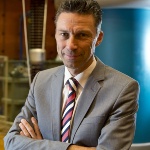Many research projects at IEH are carried out in cooperation with the industry. You will find several examples of successful collaboration under Publications. Additionally, we develop and expand new procedures as part of dissertations.
In the field of High Voltage Technology, we support you both in the further development of electrical equipment and with studies to assess the condition of your equipment fleet. We work on:
- Thermal optimization of power transformers with the help of flow simulation
- Field calculation and optimization of field control (3D-field simulations and modeling)
- Development of procedures to automatically analyze partial discharges by means of neural networks
- Development of non-conventional partial discharge measurement technology
- Development of methods to locate partial discharges by combining different measurement procedures
- Further development of the Frequency Response Analysis (FRA) for the diagnosis of power transformers
- Influence of DC currents on electrical equipment in service (power transformers, voltage/current transformers), simulation models and laboratory / field measurements
- Long-term measurement of DC currents in transmission grids. Development of appropriate measuring devices (also for outdoor usage) and support of the measurements. Analysis and localization of potential DC sources.
In the field of EMC we offer measurement and testing services but also work in the fields of research and development. Our expertises include among other things EMC aspects in automotive industry or in electric mobility and EMC observations in protection systems of medium-voltage switchgear.
- Observation of an EMC suitable interpretation and optimization of inverter driven, electric traction system in electric mobility: Geometry optimization and EMC-optimized control
- Development of different procedures to optimize active filters within the automotive industry especially regarding the minimization of the necessary assembly space
- Evaluation of EMC disturbances in inductive charging systems for electric vehicles
- Research on partial discharges in the insulation of components of the electric vehicles (e.g. stator windings and inverter insulation)
- Reduction of EMC interference with sensors of digital protection systems and observation of the robustness in order to avoid unwanted operation of protection relay
In the field of network analysis we assist you with simulation-based examination of your grids. Our services include among other things:
- Development (digitization), updating and verification of your numerical network models
- Implementation of the simulations, inter alia, in the fields of load flow and short circuits
- Development of solutions for time series and probabilistic planning of your networks
- Studies regarding network expansion and integration of renewable energies, battery storage, electric mobility, etc. in consideration of aspects like e.g. curtailment, (n-1)-criterion
- Dimensioning and placement of energy storages in the network.
- Impulse voltage generators: up to 2000 kV, 100 kJ
- Oscillating lightning impulse voltage up to 1200 kV (transportable equipment for field measurements)
- Surge current generator: 4/10µs or 8/20 µs up to 100 kA, 100 kV, 80 kJ
- AC voltage cascade generator: 2 x 400 kV/2 A, 1500 kVA supply power
- AC voltage generator: 350 kV, 0,2 A with PD measurement
- DC voltage generator: up to 600 kV, 10 mA
- EMP-Generator: up to 800 kV, 5 ns/200 ns or 2,3 ns/23 ns with outdoor antenna for test items up to 5 x 10 x 5 m3 (B x L x H)
- Voltage divider: damped capacitor voltage dividers up to 1600 kV (portable units for overvoltage measurements in the grid)
- Electric/magnetic field measurement systems: several, frequency range from 5 Hz to 500 MHz (for voltage measurement and field strength measurement in the grid)
- EMC test devices: various smaller ones for simulation of electrostatic discharges, surge generators for coupling interference voltages into the network in order to test components and devices
- EMC absorber chambers: 10 m and 3 m measuring distance, with amplifiers, various antennas, field measurement system, video surveillance via optical fibre, test receiver up to 3 GHz, TEM-measuring cell
- Climatic chamber: 3 x 3 x 3 m3, voltage up to 650 kV, temperature from -20° to +65°C

Stefan Tenbohlen
Prof. Dr.-Ing.Head of Institute

